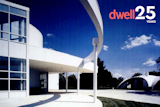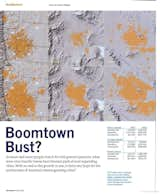From the Archive: The Problem With Building Up Boomtowns
As a part of our 25th-anniversary celebration, we’re republishing formative magazine stories from before our website launched. This story previously appeared in Dwell’s October/November 2004 issue.
Unbridled population growth in underdeveloped cities and counties often signals a financial windfall for ailing governments and civic institutions. Unfortunately, the economic good tidings are rarely matched by an upswing in quality of the architectural output. Too often these boomtowns—places like Tarrant County, Texas, or Orlando, Florida, where opportunity and cheap land seem limitless—are built up and out with what New York City-based architect Michael McDonough has called "hit-and-run architecture": structures raised as quickly and cheaply as possible in order to capitalize on the flood of new residents.
While use of the word "flood" might appear dramatic, recent numbers from the U.S. Census Bureau reveal it is wholly appropriate. Las Vegas’s Clark County, for instance, has taken over the number-four spot in terms of cumulative county population growth, elbowing its way into competition with bellwether expansionists Los Angeles County (number one) and Riverside County (number three) in California. Between April 2000 and April 2003, 200,000 additional souls (more than 5,500 a month) have found their way to the land of bright lights and all-you-can-eat buffets. Drawn by the often overblown allure of employment and warm weather, more than 1.5 million people now call the Las Vegas area home.
Las Vegas isn’t the only American city making remarkable leaps in population. Following the promise of high-tech jobs, three of Denver’s six metro area counties (Douglas, Adams, and Arapahoe) alone combined to add more than 107,000 people to the region between 2000 and 2003. And Maricopa County, which encompasses Phoenix, ranked number two on the Bureau’s list, with an additional 317,000 migrants during those three years.
But even as these cities continue to expand and their suburbs develop further into what are often called exurbs, there are architectural rumblings that are breaking the building monotony.
"I believe the Phoenix metropolitan area has a fantastic opportunity to be one of the greatest cities of this century," says Peter M. Koliopoulos, founder of Circle West Architects in Scottsdale, which just completed work on the 274,000-square-foot Market Street at DC Ranch Development. "It is really a combination of things: our natural environment, the influx of young people, the relative lack of built history compared to a New York or a Chicago, and people’s willingness to embrace new ideas."
Koliopoulos, who is originally from Chicago, sees parallels between his hometown at the beginning of the 20th century and his adopted city today. "The Phoenix area is just so young, but that is really exciting," he offers. "We are essentially creating our history as we go. My impression of this part of the country has been that our clients, and the general population, are very attuned to design and concerned about it. There is a lot of pressure to create buildings that respond to this unique environment—the desert—and that pushes people to have an understanding of how best to build here." With a number of top-notch architects like Rick Joy, Wendell Burnette, and Jack DeBartolo (to name just a few) calling Arizona home, innovative architectural solutions to the state’s density dilemmas might not be far off.
While that may be the case in Arizona, where a history of design consciousness has prevailed for years (after all, Frank Lloyd Wright began his Taliesin West in 1937 and Paolo Soleri has been conducting architectural experiments at Arcosanti, outside of Phoenix, since 1970), other cities that are feeling the population quake are not quite so lucky. "Architecturally, Phoenix is 50 years ahead of us," observes Kevin Kemner of Las Vegas firm Tate Snyder Kimsey. Unfortunately, there are a minimal number of opportunities for architects in Sin City, particularly in the residential sector. "The open land in Las Vegas is controlled by the Bureau of Land Management," Kemner explains, "and therefore the land is auctioned off in large tracts with increasingly high prices. It’s rare that there are single lots to build on. There has also been a lot more emphasis on interior space here in the past few years."
But that doesn’t mean that there’s nothing of architectural significance happening there. Las Vegas has fascinated designers and urban planners for years, and the city has long been active in supporting forward-thinking projects like the new Lloyd D. George U.S. Courthouse and Federal Building and the Clark County Detention Center, both by Mehrdad Yazdani of Cannon Design. In fact, according to Kemner, most firms in Vegas end up working on civic jobs. Tate Snyder Kimsey has been able to take on a number of large-scale buildings in the city because of this, most recently the under-construction visitor center at the Las Vegas Springs Preserve. Says Kemner, "There’s that feeling in the air that anything is possible, and that sense, thankfully, even shows up in our institutional clients, who can often be averse to risk taking." With the city and municipal governments taking the architectural lead, architects are now looking to developers to follow suit.
In Denver, that is exactly the hope—and the key to a bright future—according to architect Michael Brendle, the head of Brendle APV Architects. "Denver’s not a modern town" he says. "It’s a boom-and-bust city rooted in tradition." According to Brendle, it is the booms more than the busts that have blighted Denver. Echoing the earlier sentiments of McDonough, Brendle explains that "during the boom cycles, all of the sudden you see a lot of out-of-town firms come in, put up a lot of mediocre architecture, and leave. And when there’s a lot of building activity, all of a sudden it’s very difficult to get the subcontractors and the contractors who know how to do the kind of quality work I think the city deserves. So you see a lot of weak projects weakly executed."
But Brendle sees promise in the city for a number of reasons. "Our climate is incredible," he begins, "and Denver is at a really interesting point in its history. Older eastern cities and European cities have folded back into themselves many times over, so what you see is this interesting mix of old and new architecture—a layering. Denver is just starting to experience that. We are also starting to get architectural centerpieces like Daniel Libeskind’s forthcoming Denver Art Museum. But along with that, we need to see more high-quality work by local firms—firms that are committed to the shape of the city. If we start to see that quality on a larger scale, as the city expands, I can only see great things."
While Americans search for the elusive greener grass, these places continue to grow, garnering the population nucleus that can drive a metropolis into the pantheon of world cities. Great cities, however, compete at much more than a numbers game. But with smart planning and a healthy embrace of architecture that responds to this growing density, a walk through downtown Phoenix might start to feel like a warmer version of a stroll down the streets of Chicago in the ’30s. At least one can hope.
Published
Get the Dwell Newsletter
Be the first to see our latest home tours, design news, and more.





